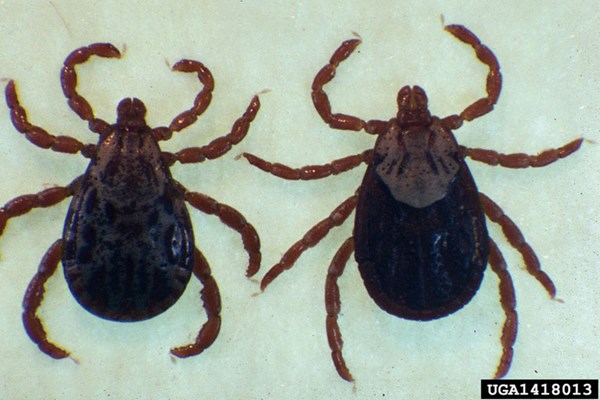
Lyme disease is caused by infection with spirochete-shaped bacteria called Borrelia burgdorferi. The disease is passed to horses, people and dogs through insect vectors, namely ticks. The particular culprits are the Ixodes ticks (black-legged and deer ticks), which, at this time, flourish in the Northeast, mid-Atlantic, upper Midwest and in pockets of the Northwest.
Populations of white-footed mice, gray squirrels, birds, and large wild mammals, like deer serve as reservoirs for Borrelia bacteria. Once an Ixodes tick obtains a blood meal from an infected mammal, it then spreads Borrelia bacteria to the next animal it bites. Transfer of bacteria from a tick bite to a horse generally requires about 24 hours of tick attachment so immediate recognition and removal of ticks lessens the chances for a horse to develop an infection. A tick attached and present for longer than 24 hours facilitates spread of Borrelia through the horse’s connective tissue and into the blood to cause systemic infection.
Infection with B. burgdorferi results in many non-specific clinical signs: Low-grade fever, shifting limb lameness, muscle tenderness, muscle wasting and weight loss, stiff gait, lethargy, behavioral changes, increased sensitivity of skin to touch, and uveitis (inflammation of the eye tissues surrounding the pupil). Joint swelling can occur but is less common in horses than in dogs and people. Rarely, an infected horse may experience neurologic signs, referred to as neuroborreliosis. Not all horses infected with B. burgdorferi develop clinical signs but for those that do, it can take up to six weeks to exhibit clinical signs of infection.
Anaplasmosis
Another disease carried by ticks is referred to as equine granulocytic ehrlichiosis or anaplasmosis caused by Anaplasma phagocytophilum (previously called Erlichia equi). Blacklegged ticks (Ixodes pacificus or scapularis, aka deer ticks) and the Lone Star tick (Amblyomma americanum) are common vectors for disease transmission.
An infected tick transmits the bacteria that invade a horse’s white blood cells, resulting in destruction of red and white blood cells and platelets. Clinical signs develop after a 1-2-week Incubation period – high fever (over 104 degrees Fahrenheit), depressed appetite, depression, limb edema (swelling), petechial hemorrhages (tiny blood spots on mucous membranes of gums and inner tissue of the nose), icterus (jaundice), and reluctance to move due to muscle soreness and/or ataxia (incoordination).
Piroplasmosis
Two different parasites—Babesia caballi and Theileria equi–can be transmitted to a horse’s blood when an infected tick feeds on a horse or through blood-contaminated equipment, needles, or blood transfusions. Infection with either of these parasites is referred to as equine piroplasmosis (EP) or babesiosis.
The most common ticks involved in transmission of piroplasmosis are the tropical horse tick, Southern cattle tick, the Cayenne tick, and the American dog tick (Dermacentor variabilis). After 1-2 weeks incubation, an infected horse shows signs of mild to general weakness, depression, loss of appetite, fever, anemia, limb selling, respiratory difficulty, jaundice, dark-colored urine, and a pregnant mare might abort the fetus.
EP is a reportable disease. Besides having a high fatality rate, a “recovered” horse remains a carrier despite treatment and resolution of clinical signs.
Spinose Ear Ticks
One form of tick likes the inside of equine ears. Soft spinose ear ticks can induce muscle cramping or a neurologic condition that resolves upon removal of the ticks from the ears.


